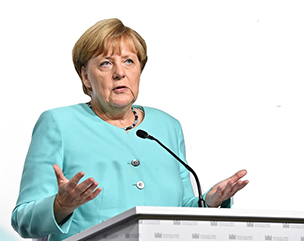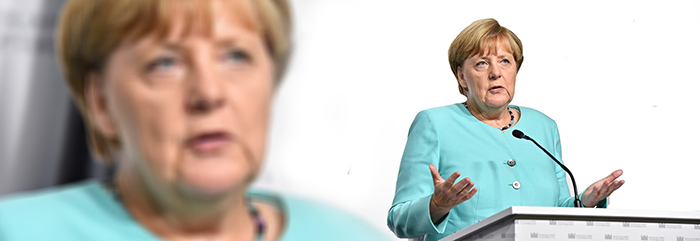Why Germany should introduce an ambitious carbon price


Simon Dietz, Tobias Kruse, Isabella Neuweg and Lutz Sager argue that Germany should set out a clear plan for a stronger carbon price as an effective route for reducing greenhouse gas emissions that can also improve the circumstances of lower-income households.
A heated debate over the best way for Germany to reduce its greenhouse gas emissions has taken place over the past few weeks. As the argument raged, in mid-May Chancellor Angela Merkel announced that the country aims to become carbon-neutral by 2050. However, the leader of Dr Merkel’s Christian Democratic Union party, Annegret Kramp-Karrenbauer, had previously denounced a carbon tax, claiming that it would disadvantage ‘ordinary people’.
Ms Kramp-Karrenbauer’s claim is incorrect. Most governing political parties across the world have shied away from introducing a strong carbon price out of fear that it would disadvantage domestic industries and households, afraid of losing public support. But in fact strong carbon prices alongside complementary policies have proven effective: they can reduce emissions at scale while offering the opportunity to reduce costs for lower-income households; they are the most effective and efficient way to reduce emissions.
Pricing carbon encourages emissions to be reduced where it is cheapest to do so, is easier to get right than regulation, and sends a clear signal that the polluter must pay. A price on emissions creates an incentive for producers to cut pollution and for consumers to buy less polluting goods and services. It can induce innovation by businesses. It can make the air in cities cleaner and streets quieter.
Designing policy to prevent a hit on poor people
Carbon pricing does not come without its costs – as with every policy. One concern that is often raised, and indeed the one that was highlighted by Ms Kramp-Karrenbauer, is that carbon pricing may disproportionately hurt individuals and households on lower incomes. This concern is real and should be taken seriously when carbon pricing is applied directly or passed through to consumers. However, these impacts can be ameliorated through sensible policymaking.
Carbon pricing would result in higher prices for emissions-intensive goods and services – that is its intended outcome. And it is also true that, at least in rich countries, individuals and households on lower incomes on average spend a larger share of their money on energy-intensive goods such as electricity, heating and transport fuels. At the same time, households and individuals on higher incomes spend more in absolute terms on energy-intensive goods and services. If the price of such goods and services goes up, then lower-income consumers would experience potentially the largest proportional impact on their incomes, but higher-income consumers would pay more in total.
Public policymakers can compensate lower-income individuals and households to prevent any increase in hardship. This is particularly important if the carbon price creates revenue for governments, for instance through a carbon tax or an auction for emissions allowances, as it can be potentially redistributed fully or partly to individuals and households. The more money collected, the more that can be redistributed. If it is paid out so that lower-income groups receive a larger share of the revenue, the fact that they have spent relatively more of their incomes is then offset. They could even receive more out than they paid in, depending on the design of the redistribution and if enough of the revenue is earmarked for redistribution.
Per-capita redistribution as a lump sum to increase acceptability
In other words: what happens to the revenue will significantly shape how the costs of carbon pricing are distributed. Redistribution of the revenue can make the net effects of carbon pricing much less regressive and possibly even progressive on the whole. This possibility is often forgotten or ignored by opponents of carbon pricing.
Of course, the objective of carbon pricing is to reduce emissions, and, if ultimately successful, it will mean that eventually revenue is no longer generated at all, even at high price levels. Nevertheless, significant revenues can be generated until emissions are eliminated.
Some economists argue that revenues collected by governments from carbon pricing should not be hypothecated – that is, earmarked for a specific purpose. Annual payments to citizens from the carbon price revenues (lump-sum per-capita redistribution) constitute a form of hypothecation. There are strong arguments for channelling the revenues from carbon-pricing into the general government budget instead: firstly, because it is more efficient – the money can be used where it is needed most and the administrative burden of implementing such a scheme is low. Secondly, because it could be used to remove distortionary effects of income taxation, which could also benefit lower-income households on balance. Thirdly, because it is more flexible, due to the fact that the use of the revenue can be adapted to changing country circumstances.
Nevertheless, there is evidence that the public will not support carbon pricing if the revenues only flow into a government’s general budget. Research has shown that earmarking the revenue and directly redistributing it to individuals and households can be popular. Lump-sum per-capita redistribution of the revenue could therefore lead to public acceptability of a strong carbon price and create vested interests in its creation and maintenance. These two arguments in favour of hypothecation weigh particularly heavily in light of the urgency with which Germany needs to reduce its emissions and the crucial role a strong carbon price plays in this.
How high?
A carbon price needs to be sufficiently high to induce the required change in behaviour of businesses and households. The High-Level Commission on Carbon Prices concluded that, to be consistent with the goals of the Paris Agreement, carbon prices in 2020 should range from €35 to €70 per tonne of carbon-dioxide-equivalent and should rise to €45 to €90 by 2030, depending on the country.
For Germany, Ottmar Edenhofer and Matthias Kalkuhl have calculated the burden to consumers from a carbon price with per-capita redistribution of the revenue. They analysed the likely impact of starting with a price of €20 per tonne of carbon-dioxide-equivalent, increasing gradually to about €60 per tonne of carbon-dioxide-equivalent after 2020. With a €60 per tonne price, they calculated that everybody in Germany would receive €162 per year compared with a scenario without a carbon price. A family of four would receive over €200 more per year (this is the net effect: i.e. after the effect of the carbon price on goods and services has been taken into account; the net effect varies depending on household size, wealth and lifestyle carbon-intensity).
Of course, there are other ways of helping the poor (possibly alongside the per-capita redistribution we describe here). As mentioned above, they include allocating the revenues for spending needs as required or to lower the effect of distortionary income taxes, but these are both actions that the public finds difficult to accept. As an alternative, some or all of the revenue generated from carbon pricing could be used to benefit individuals and households by removing existing energy taxes on household heat generation in Germany instead, or to increase Germany’s contribution to climate finance for developing countries.
Time to seize the moment
In short, the revenue from carbon pricing can be used to significantly reduce the burden on citizens, and in particular to compensate for the effect on low-income households and even reverse it so that those households receive more money than they pay out. This possibility needs to be acknowledged in the public discussions about carbon pricing and communicated more clearly by policymakers.
The current debate in Germany about which policy instruments to choose in order to rapidly decrease emissions, together with the ‘Fridays for Future’ school strikes and the strong results for the Green Party in Germany in last month’s European Parliament elections, illustrate that there is strong support for action on climate change. It is now time for politicians in Germany to set out a clear plan for carbon pricing. It can be a route to improving the circumstances of low-income individuals and households, and it will lead to emissions reductions that create tangible benefits in terms of wellbeing and quality of life for future generations.
Edits were made to the original version of this commentary on 5 July to clarify the amount that people would receive with a €60 per tonne price.
We are grateful to Georgina Kyriacou for copy-editing this commentary and to Dr Alex Bowen, Joshua Burke and Bob Ward for their helpful comments without wishing to implicate them in the views expressed in this commentary, which remain those of the authors.

